Harris Hotel
Introduction
Text-to-speech Audio
Seaborn J. Harris was a well-known businessman and hotelier in north Louisiana. His hotel in Ruston was the most prominent structure in town for decades. The Harris Hotel was located on this corner. Although the hotel burned in 1927, much of the ground floor was saved. Note the steel columns on the front that remain from the original building. Hotel rooms were available upstairs while the downstairs has always contained retail shops. The corner establishment operated as Ruston Drug Company for many years.
Images
Harris Hotel
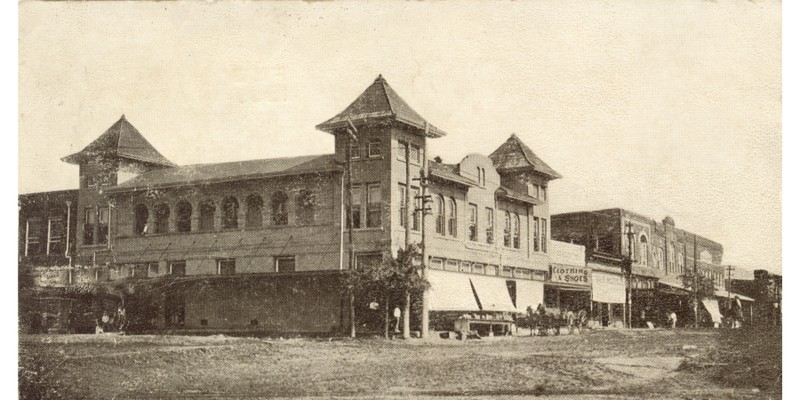
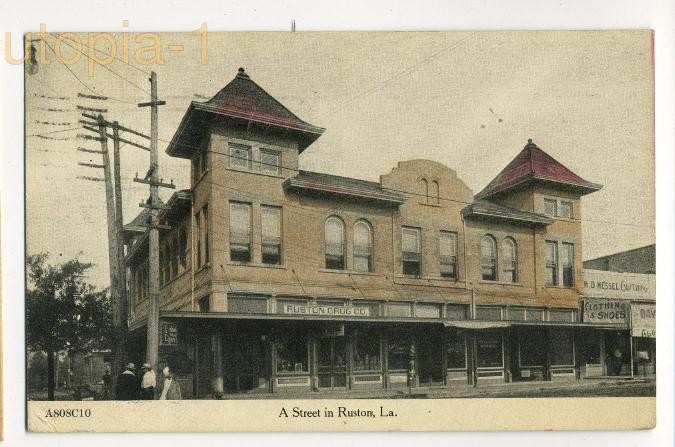
Ruston Drug Company. The original floor remains.
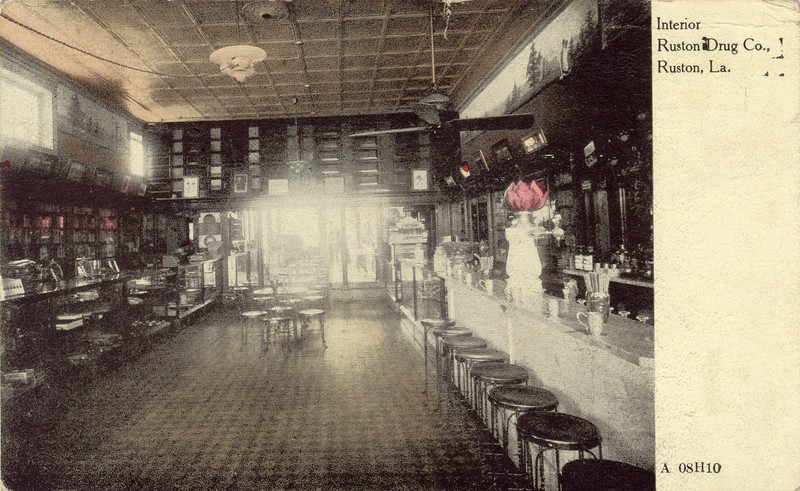
Stinson's Music Box was a popular retailer in 50s-70s in the remnants of the Harris Hotel.
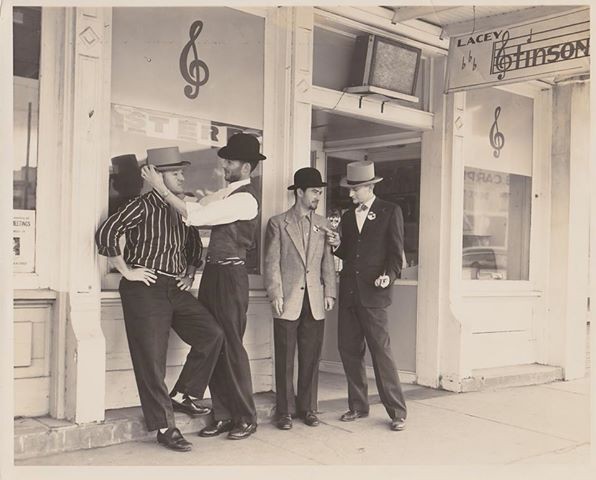
Moffett Barber Shop inside Harris Hotel. Current address is 103 North Trenton.
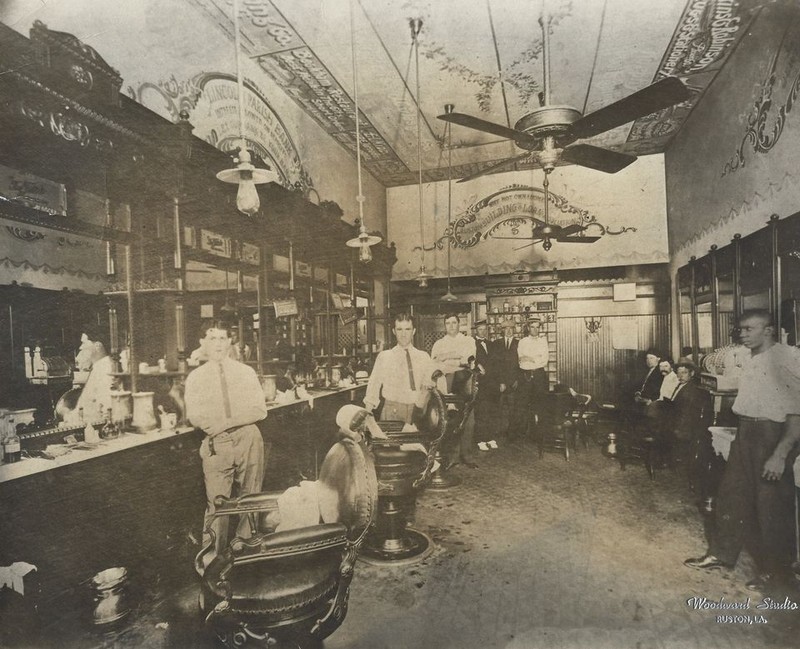
Ruston Drug on the first floor of the old Harris Hotel, 1929. This space is now occupied by the Park Avenue Diner.

Sources
HISTORY OF THE HARRIS HOTELS
Seaborn J. Harris was a well-known businessman and hotelier in north Louisiana. His hotel in Ruston was the most prominent structure in town for decades.
Born in Alabama, Seaborn Harris later moved to the small village of Shiloh in Union Parish. The 1870 census listed Seaborn Harris as a 22-year old farmer but by the 1880s, he was engaged in several business ventures. An article in the Arkansas Gazette on November 5, 1892, mentions S.J. Harris and Co. as a Shiloh general merchant and cotton buyer since 1882 and a successor of White & Harris, a general mercantile firm operating since 1880. The paper stated,
“Harris and Company has a stock of $10,000 and had purchased 1,103 bales of cotton. S. J. Harris is the senior member of the firm and though an Alabamian, is to the manner reared in this locality and is one of the most enterprising and public spirited men the writer has met in North Louisiana. Before his advent in commerce
he was almost exclusively engaged in stock dealing and hence, would be good authority upon either the business of the place or stock raising which is destined to cut no little figure in the future once
this immediate country is understood. It should be added that Mr. Harris is the head of the Ruston and Shiloh Telegraph Company and at the same time is the owner of the Shiloh Hotel, which every drummer who makes this territory proclaims as the best hostelry of the North Louisiana interior.”
In addition to his numerous business ventures, Harris served as Shiloh’s postmaster in 1894-95.
Another mention of Harris’s Shiloh hotel appeared in the New Orleans Picayune on November 6, 1892, in an article by a female travel writer:
“We had threaded this forest, penetrated its opposite, a bit of swamp land--all cypress trees and red trees that look frost-bitten—which margin Bayou D’arbonne as one travels from Ruston to Shiloh, and Union Parish. Beyond the reach of swamp was a long hill and fine farmlands, now lost in the common blur of a driving rain.
"We had lost our way and wandered woefully, the pony slipping and falling on the waxy hills, the old wind biting like the teeth of time or want. It was 9 o’clock before we found the front door of the Harris Hotel, and with fatigue I automatically climbed down and went into a large room, where a great oak fire flashed on the hearth, the epitome of a royal welcome. A fine old farmer told me the other day that his idea of comfort was to travel all day in the cold rain on horseback, and come just at nightfall to a big country house, a roaring fire on the wide hearth and a hot supper by its side.
"One of the thriftiness, neatest and most interesting little towns in North Louisiana is Shiloh. In all our small towns and villages were as neat and plucky and as ambitious, no one in the state need then complain. When the branch of the Iron Mountain Road [the railroad], now building to the South passes through Shiloh, its cotton shipments, now 5,500 bales, will increase to 20,000 bales.”
Unfortunately for Shiloh, the railroad route was plotted further to the west. Residents and businesses began migrating to the towns like Ruston that would see the coming of the north-south route.
The Harris family moved to Ruston in 1896 which already boasted an east-west rail line and expected to be on the north-south route. The Harrises remained in the hotel business by managing the Arlington Hotel, which was located downtown beside the Vicksburg, Shreveport & Pacific Railroad opposite Railroad Park. Seaborn’s son Young A. Harris operated a livery stable. Young Harris served in the Ruston Rifles, part of the 1st Louisiana Volunteer Infantry that served in the Spanish-American War.
Seaborn purchased a building at the northwest corner of Trenton Street and Park Avenue built around the turn of the century by a Monroe businessman. This was the first site of Ruston’s Harris Hotel. The guest rooms were located on the second floor and in three parapets located on the corners facing the streets. Most of the ground floor was occupied by separate businesses, including Ruston Drug Company and a barber shop.
This structure
Although most of the building was destroyed a 1927 fire, much of the first floor framework remained, including the manufactured steel columns that lined the exterior of the building. These façade columns are still visible on most of the Trenton Street side although all the ones on the Park Avenue side have been covered in plaster. Mrs. L. M. Heamel renovated the building absent the second floor, covering much of the building in stucco. More recent renovations have revealed charred wood and soot-covered brick from the fire. No Ruston newspapers remain from 1927 to describe the cause or nature of the fire, but the location of the building on the corner of the block with brick walls separating it from the Ruston State Bank on the north and another building on the west probably helped contain the blaze to the hotel only.
Ruston Drug reopened in its original location. For most of its existence, the pharmacy was operated by the Cupp family.
The center section continued as a barber shop, at least into the late 1930s. Thomas Ashby Moffett was the barber in 1938, according to the annual telephone directory. The barber shop space was later occupied by a variety of businesses, including Stinson’s Music Box, Ruston’s first record shop. Stinson’s opened at 103 North Trenton about 1956 and moved to another location around 19 .
The northern most portion of the renovated building was occupied by Glasgow’s clothing store for many years.
Young Harris later operated what was known as the Harris Hotel Annex in the 200 block of North Trenton. His name “Y.A. HARRIS, 1910” (1916??) still appears on the building. Like the original Harris Hotel, the downstairs was occupied by various businesses with guest rooms upstairs.
After the main hotel burned in 1927, the Harrises acquired a structure located directly behind the destroyed facility on Park Avenue. It was alternately referred to as the Harris Hotel, Hotel Ruston, and other names. During World War II, it was taken over by the Womens’ Army Auxiliary Corps for housing for its officers who were supervising trainees at Camp Ruston. It is often referred to as the “Stow’s building” after a popular bar that occupied it for many years. Today, it houses two businesses, The Fashion and the Chartreuse Pear.
Young Harris’s son, Dr. John B. Harris, established a hospital upstairs in the Park Avenue location and later a clinic in the Trenton Street annex. His name is stenciled on one of the upstairs windows.
Harris Hotel mentioned in The Official Hotel Red Book & Directory. New York: Official Hotel Red Book & Directory Company, 1917. Rooms listed at $2.50-$3/night.
Lincoln Parish Museum
Lincoln Parish Museum
Lincoln Parish Museum
Woodward Collection, Lincoln Parish Museum
Lincoln Parish Museum
